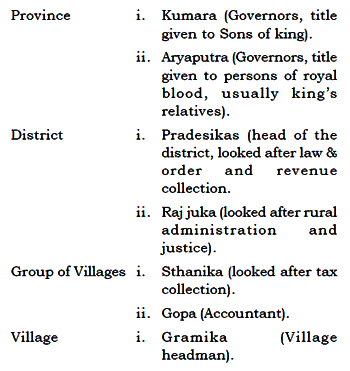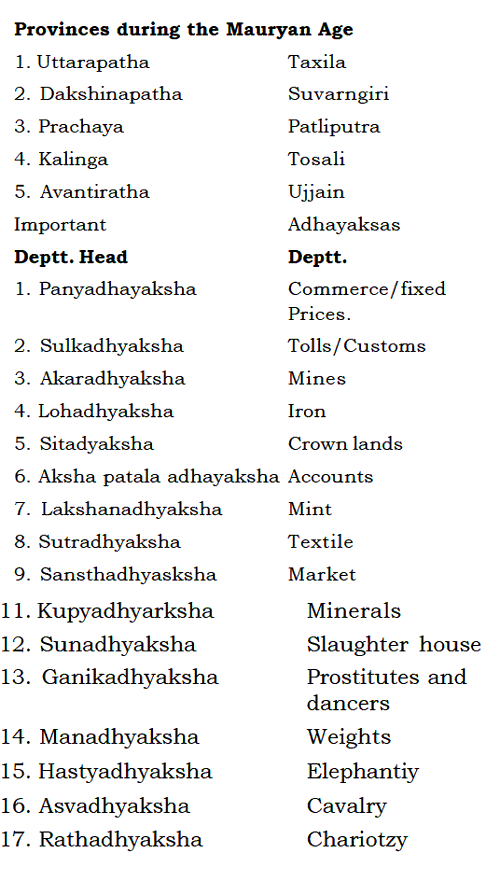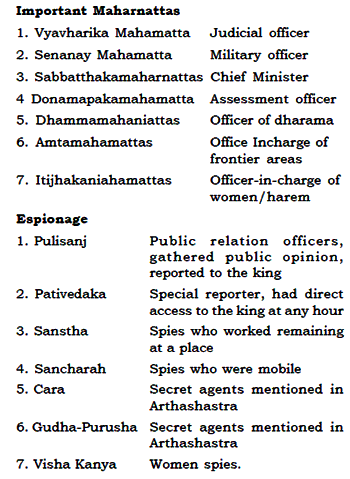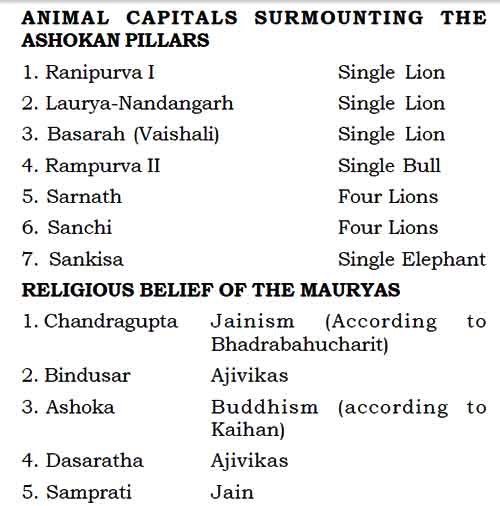(HOT) UPSC Current Affairs 2025 PDF
NEW! The Gist (NOV-2025) | E-BOOKS
(IGP) IAS Pre: GS - Indian History - Ancient India : The Mauryan
Indian History
The Mauryan
Chandragupta founded it in 322 B.C. with the help of his Brahmin Minister Chanakya.
References and Sources:
The most important source in Artha Sastra which has 15 chapters called Adhikaranas. Other Sanskrit sources are Kaumudi Mahotsava of Vajika and Mudraraksha of Visakhadutta. Sangam poets
named Mamulnar and Pamar described about Bimba Mauryas attack on South India.
| 1. Division of Indian Society into seven castes | Megasthenes |
| 2. Absence of slavery | Megasthenes |
| 3. Chronology and list of Mauryan Kings | Puranas |
| 4. Economic and Political Conditions | Arthashastra |
| 5. Social and Economic Conditions | Jatakas |
| 6. Role of Ashoka in spreading Buddhism to Sri Lanka | Dipvamsa & Mahavamsa |
| 7. Conversion of Chandragupta Maurya to Jainism — his abdication of throne and going to Sravanbelagola |
Parisistparvan of Hemachandra |
| 8 Absence of usury (Money lending) | Megasthenes |
| 9. Ashoka’s favour to Ajivikas | Barabar Hill cave inscriptions |
| 10. Construction of Sudarsana Lake | Junagarh Rock Inscription of Rudradaman I. |
| 11. Killing of 99 of his brothers and seizing of throne by Ashoka | Mahavamsa & Dipavamsa |
| 12. The name Ashoka | Maski Gujarra, Nittur and Udegolam Edicts |
| 13. Existance of an Ashokan Pillar at Sanakisa with a lion capital | Fa-hien |
| 14. The Mauryan army is band of dacoits | Justin |
| 15. Jaluka was the successor of Ashoka in Kashmir | Rajataringini |
| 16. Pushyagupta the provincial governor of Saurastra was the brother-in-law of Chandragupta Maurya |
Junagarh Rock Inscription |
| 17. Mauryan army consisted of 600000 army men | Plutarch |
| 18. Bindusar asked Antiochus of Syria for some sweet wine | Hegesander (quoted by Atheneus) dried figs and a philosopher |
Central Administration
| Adhyakshya | High ranking officials next to Tirthas concerned mostly with economic functions and some military duties. They were twenty in number. |
| Amatyas | High ranking officers who acted as present day secretaries, who functioned in administrative and judicial capacity. |
| Mahamattas | Higher ranking officials irrespective of the duties assigned of them. These are references to them as a ministerial of advisory council as well. The Arthasastra uses this term in the sense of a minister. |
| Tirthas | Highest category of officials form the inner council apart form council of ministers. They were eighteen in number. |
Administrative Divisions and Officers Associated with them

Provinces during the Mauryan Age

Click here to download full Chapter
DOWNLOAD UPSC MAINS HISTORY 11 YEARS SOLVED PAPERS PDF
DOWNLOAD UPSC MAINS HISTORY 10 Years Categorised PAPERS
Study Noted for UPSC MAINS HISTORY Optional
Important Maharnattas

Army
- Plutarch and Justin have described about Chandraguptas army.
- Size and organisation of army was fairly large.
- According to Pliny it comprised 60000 infantry, 30000 cavalry, and 10000 elephants.
- According to Plutarch it consisted of 20000 infantry, 80000 horses, 6000 elephants and 8000 war chariots.
- Chanakya refers to Chaturangbala comprising infantry, cavalry, chariots and elephants as the principal organs of the army.
- Army administration was run by six committees (according to Megasthenes).
- Each committee consisted to five members (according to Megasthenes).
- Each committee was entrusted with a particular branch namely infantry cavalry elephants, chariots, admiralty and transport & supplies.
- The officers and soldiers were paid in cash.
- Salaries of some important officers were: Senapati-4800 pana, Nayaka- 1200 pana, Mukhyas-8000 pana, Adhyaksha 4000 pana.
City Administration
- Megasthanese has given prohific information on Municipal administration of pataliputra whIch was devided in to 30 words.
- Run by a city council known as Astyanomi
- City council consist of six sub-councils/ committees
- Each committee had five members.
- Each committee was entrusted with a particular work namely:
- First Committee - Industry & crafts
- Second Committee - Foreigners
- Third Committee - Registration of births & deaths
- Fourth Committee - Trade & commerce, weights & measures
- Fifth Committee - Manufactured goods
- Sixth Committee - Collection on the goods sold
- Head of the city administration was Nagraka.
- Nagrika wa assisted by two subordinate officials namely: Sthanika & Gopa.
- Rakshi was the police who looked after the people's security
Taxes
- Sita-Crowniand
- Bhag-Land tax— 1/6
- Bali-Voluntary offering
- Vastu-Tax taken from rural areas
- Durg-Tax taken from urban areas
- Kara — Orchard tax
- Vivit-Tax imposed on pasture land
Facts about Ashokan Edicts & Inscriptions
- Maski Gujarra, Nittur and Odegolam edicts mention the name Ashoka
- Ashokan edicts were deciphered by James Princep in 1837.
- The Topra & Meerut Pillars were brought to Delhi by Firoz Shah Tughlaq.
- The Kausambi Pillar was brought to Allahabad by Jehangir.
- The Bairat inscription was brought to Calcutta by Cunningham.
- The major rock edicts at Manshera & Shahbazgarhi are in Kharoshthi script.
- The Kandahar inscription is bilingual written in Greek & Armenic.
- Most of the Ashokan edicts are written in Brahmi script.
- The language used in Ashokan edicts except Kandhar is Prakrit.
- The inscription in fragmentary condition found at Lampaka/Lamghan is in Aramaic.
- In edicts Ashoka generally refers to himself by the title Devanampiya Priyadarshi.
- The Allahabad pillars (brought from Kausainbi) contains the inscription of Samudragupta and Jehangir also.
- Major rock edicts are fourteen in number.
- Total number of pillar edicts is thirteen, they are inscribed on ten pillars-out of thirteen seven are major pillars edicts and two are commemorative pillar edicts.
- Of the four minor pillars edicts, one is known as Queen’s edict and it is on Allahabad pillar. This was dedicated to Ashoka’s wife Tisrakshita. In this inscription the description of his son Teevar was found.
- Schism edicts (one each) are found on Allahabad, Sanchi and Sarnath Pillars. There are called the inscription for stopping the division.
- The commemorative pillar edicts are Rumeindei and Nigalisagar (both in Nepal)
- The longest among the major rock edict is 13th rock edict. In this edict the war of Kalinga has been described. The ‘slave system has also been described in this edict.
- 7th Pillar edict is longest among all the edicts.
- The Allahabad pillar contains first six pillar edicts, Queen’s edict, Kosam Schism edict, Prasasti of Samudragupta written by Harisena and some decrees of Jehangir.
- Kharosthi script was admixture of Armeic and Brahini.
Various Edicts
- Contents — Personal history of Ashoka
1st Edicts
- Don't kill any animal except dear and Peacock.
Peacock
3rd Major Rock Edict
Ashoka has created 3 new post.
- Pradeshika — District Magistrate.
- Rajjuka — Reveneue officer, who also looks after the judicial things.
- Yukta — Correspondence clerk.
5th Major Rock edict
Ashoka created new post of Dhartna Mahamatya.
6th Major Rock edict
In this edict it has been mentioned that Prativedaka can meet anywhere to king regarding state affairs
8th Major Rock edict
In this edict it has been mentioned that at the 10th year of his ruling Ashoka went Bodhgaya and worshiped pipal tree.
13th Major Rock edict
This is the Biggest edict in which war of kalinga has been mentioned. The description of Satlyaputra found here.
14th Major Rock edict
“My Kingdom is vast.”
Location — 1. Shahbazgarhi (Peshawar) 2. Mansehra Peshawar) 3. Kalsi (UP) 4. Sopara (Maharashtra) Girnar (Gujarat) 6) Dhauli (Orissa 7. Jaugada (Orissa).
2. Minor Rock Edicts
- Contents —Personal history of Ashoka
-
Location—1. Siddapura (Karnataka) 2. Jatinga Rameshwara (Karnataka) 3. I3rahmagiri (Karnataka) 4. Rupnath (MP) 5. Shasaram (Bihar) 6. Bairat (Rajasthan) 7. Maski (Karnataka) 8. Govimath (Mysore) 9. Palkigundu (Mysore) 10. Rajula Mandagin (Karnataka) 11. Yerragudi (Karnataka) 12. Gujarat (MP) 13. Ahraura (UP)
3. Major Pillar Edicts
- Contents— These are appendix to rock edicts.
- Location — 1. Allahabad (UP) 2. Delhi Topra (Punjab) 3. Delhi-Merritt (UP) 4. Lauriya Areraj (Bihar) 5. Lauriya Nandangarh (Bihar) 6. Rampurva (Bihar)
4. Minor Pillar Edicts
- Contents—Ashoka’s Obsession with Dhamina
- Location — 1. Allahabad (UP)2. Sanchi (UP) 3. Sarnath (UP)
5. Kalinga Edicts
- Contents — System of administration in Kalinga
- Location — 1. Dhauli (Orissa) 2. Jaugada (Orissa)
6. Bhabru Edicts
- Contents — Ashoka’s conversion to Buddhism and his reverence for his religion
- Location — Calcutta (WB) brought from Bairat (Rajasthan)
7. Barabar cave Inscription
- Contents — Donation of the caves to Ajivikas
- Location — 1. Barabar Hills (Gaya, Bihar) 2. Number of caves in three namely Banyan tree (Sudama) cave, Khalatika/Visvajhopri cave and Supiya/Kama Chaupar Cave
NAMES OF CHANDRAGUPTA MAURYA
- Sandokoptos - Phylarchus (quoted by Athaneous)
- Sandrocottus - Strabo, Arian, Justin
- Palibrothers - Adopted by king
- Patliputraka - Adopted by king
- Androcottus - Appian plutarch
- Chandra Sin - Mudrarakshasa
- Piadsama - Mudrarakshasa
- Pnyadarshana - Mudrarakshasa
- Vrishala - Mudrarakshasa
- Kulahina - Mudrarakshasa
- Maurya Putra - Mudrarakshasa
- Piyadassi - Mudrarakshasa
NAMES OF BINDUSAR
- Amitraghata - Sanskrit (literally slayer of forces)
- Amitrakhada - Sanskrit (literally eater of forces)
- Arnitrachates - Athaneous
- Allitrochades - Strabo
- Simasena - Rajavalikatha
- Bindupala - Fa-Puen Chulin (A Chinese text)
NAMES & TITLE OF ASHOKA
- Ashoka - Personal name
- Priyadarssi - Official name (probably used after coronation)
- Devanampriya - Royal title (Ageneral royal title of the period)
- Ashoka - Maski, Nittur, Gujarra & UdegolamEdict
- King of Magadh - Bhabru edict
- Ashokvardhan - Puranas
- Ashoka Maurya - Junagarh Inscription
- Priyadarsi - Dipavamsa
- Priyadarsi - Kandahar Inscription
- Priyadarsi Raja - Barabar hill cave Inscription
FOREIGN EMISSARY/AMBASSADOR IN THE MURYAN COURT
- Megasthenes — by - to the court of Seleucus Chandragupta Mauryas
- Deimachos
- Antiochus I, King of Syria — by - to the court of Bindusar
- 3. Dionysios — by Ptolemy II - to the court of Bindusar

MAURYAN COINS
- Punch-marked coins mainly of silver and some of copper found from eastern U.P. and Bihar.
- The most common symbols are the elephant, the mountain and the tree
- Pana — 1, 1/2, I/4, 1/8 — Silver
Masika—l, 1/2, 1/4, l/8 — Copper
Kakini — 1/4 of Masika - Symbols on Punched-marked coins-Mountain, Stupa, Animal, Tree Branches. Weapons & Tools, Human Figures, Dog Seizing Hare, Rabbit, Fish, Scorpian, Snake, Sun Sadarachakra.
FACTS ABOUT ARTHSIIASTRA
- Came to light in - 1905 by Shamji Sastri
- Written by - Chanakya/ Kautilya
- Subject Matter - State craft.
- No. of adhikamas (books) - Fifteen
- No. of verses - Six thousand
- Expanded and perfected by - Vi s h nug u p t a (300-400 A.D.).
Click here to download full Chapter
Click Here for The Mauryan MCQ
DOWNLOAD UPSC MAINS HISTORY 11 YEARS SOLVED PAPERS PDF
DOWNLOAD UPSC MAINS HISTORY 10 Years Categorised PAPERS
Study Noted for UPSC MAINS HISTORY Optional
© UPSCPORTAL.COM


